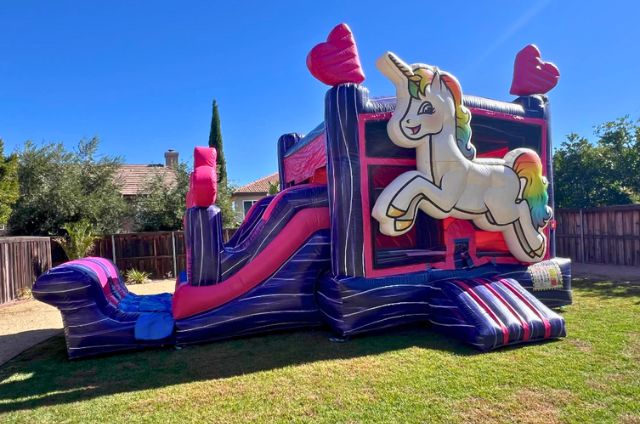Bounce House Safety Without the Stress: A Parent’s Guide

Simple ways to support safe, joyful play—without the mental load
When you’re planning a celebration, it’s easy to get pulled in a hundred directions—cake, RSVPs, decorations, weather plans. And tucked somewhere between all that? The quiet hope that the bounce house will be just as safe as it is fun.
The good news? Bounce houses are designed for exactly this kind of play—active, joyful, high-energy fun in a space that feels magical to kids. And with a few thoughtful decisions up front, you can feel just as confident about what’s going on inside the inflatable as you do about the rest of your party.
What Does “Safe” Really Look Like?
Safety doesn’t mean stress. It means confidence—the kind that comes from knowing the inflatable is secure, the play is supervised, and the fun can flow without a second thought.
You don’t need a clipboard or a rulebook. You just need a few thoughtful practices that help everything fall into place:
- A setup that supports safe, active play
- Clear space around the unit, free from clutter or obstacles
- Ground rules that are easy for kids to follow
- One adult nearby to keep an eye on things
That’s it. No overthinking. No second-guessing. Just simple choices that help everyone feel good about what’s happening in the backyard.
Setting the Stage: Bounce House Setup Basics
Most bounce houses today are built with smart safety features: mesh windows, soft walls, easy-access entrances, and built-in guidelines from the manufacturer. The key is making sure the setup follows a few simple principles:
- Flat surface: The bounce house should sit on level ground, free from slopes, branches, or clutter.
- Anchored well: Depending on the surface, this could mean heavy-duty stakes (for grass) or sandbags (for pavement).
- Clear zone: Leave 3–5 feet of open space around the inflatable.
- Stable power: The blower should plug into a grounded outlet, ideally no more than 50 feet away.
If you’re working with a rental provider, ask them to walk you through their setup process. Many will even show you how the anchoring works or go over care instructions before they leave.
Calm, Confident Supervision
The heart of safe bounce house play isn’t in rules—it’s in presence.
Having one adult keeping an eye on the bounce house at all times is often all it takes. Not as a lifeguard or a referee, but as a calm presence who’s available if needed.
Here are a few low-stress ways to keep things smooth:
- Group by age or size: Rotate younger kids in with a helper to avoid overcrowding.
- Set expectations early: A quick “house rules” huddle makes a big difference. No flips, no food, no shoes.
- Time limits = more fun: Breaks help kids reset and reduce fatigue.
- Keep it simple: One inflatable, one adult nearby, one rhythm of play.
You don’t have to hover. You just need to be within view—and maybe have a lawn chair nearby.
Your Simple Bounce House Safety Checklist
If you like having something in writing, here’s an easy reference list you can keep on the fridge or hand to your event helper.
✅ Before the party:
- Bounce house is on level ground with enough clearance
- Anchors or sandbags are secure
- Blower is plugged in to a grounded outlet
- Entrance and exit are easy to access
- Unit is clean and dry
✅ During the party:
- Adult supervisor assigned
- Kids remove shoes and accessories
- Play is limited to similar ages or sizes
- No food, drinks, or toys inside
- Everyone gets regular breaks
This isn’t about perfection—it’s about creating a space where you can relax knowing the basics are handled.
Frequently Asked Questions About Bounce House Safety
How many kids can safely use a bounce house at once?
Most standard bounce houses (13×13) can comfortably hold 6–8 children under age 8. Larger units or combos can handle more, but always follow manufacturer guidelines.
Are bounce houses okay for toddlers?
Yes, many are! Look for toddler-specific designs with lower entry points and gentler bounce zones. For mixed-age events, give toddlers their own bounce time to shine.
Can bounce houses go on concrete?
Definitely. They just need to be weighted down properly with sandbags instead of stakes, and padded entry mats are often used to soften the area around the entrance.
What’s the age range for bounce houses?
Most inflatables are made for ages 3 and up. Just like with playgrounds, the key is making sure kids play with others around their size.
How windy is too windy?
In general, anything over 15 mph is considered a good time to pause or deflate. That said, many rental providers will proactively guide you based on local conditions.
Safety Is What Makes the Fun Possible
Here’s the truth: no one remembers the exact size of the inflatable or how many balloons were in the yard. What they remember is how it felt. The laughter, the freedom, the moments when everything just clicked.
Safety helps create that feeling—not by limiting fun, but by supporting it. It gives kids the room to be wild, joyful, and fully present… while you can take a breath, chat with other parents, or maybe even grab a second slice of cake.
Want to Go Deeper?
For a more complete breakdown of equipment types, sizing, and planning tips, check out this Bounce House Rentals 101 Guide.
And if you’re still browsing for the right setup, this bounce house rental collection is a great place to explore what’s out there.
Still deciding? Bookmark this post or print the checklist. The most memorable moments start with confidence.

